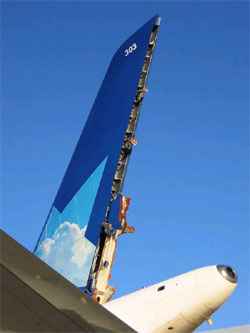
Wet Paper Sack ( Honeycomb Structure )
Wet Paper Sack
Did you know that many airplanes use paper for strength?
Imagine a PB&J sandwich. Now imagine that the 'bread' is made of fiberglass, and the Jam is made of a thick slice of perforated paper. If you do like I do when I eat a PB&J, then you smash it really thin before eating it. This is, in essence what composite honeycomb is. Have a look:
 Now, having a thick core like this is actually a 'good thing'. It keeps the structure light and gives it strength. These are also 'good thing's for airplanes.
Now, having a thick core like this is actually a 'good thing'. It keeps the structure light and gives it strength. These are also 'good thing's for airplanes.But there's a problem. When paper gets wet, what does it do? It falls apart, right? that means that if water somehow got into your composite then your core can fail, the composite colapses and *poof*, no more structural member. Now, normally, well made composites are sealed from the atmosphere. H2O can't get in, and everything is fine.
Just for fun, though, let's imagine that there's a small crack in the composite. It's tiny, hardly even visible; in fact, you can't see it but it's there. Let's say this composite is part of an airplane that does lots of takeoffs in a hot tropical climate. At 30,000 ft the air temperature is -50. What might happen to the warm, moist air that gets into the composite? It condenses, right? Right. As Julia Roberts once said 'Big mistake. Huge!' Now do this, say 500 more times, and now the water starts to pool in the composite. Check this out:

The green sections represent water in the composite. If this were a paper core, then it wouldn't be long before that core fails, and quickly thereafter, the rest of the composite. And failure or delamination, as it's called, is caused by not just water, but almost any type of fluid that can saturate the paper. Here's a report from the TSB of Canada detailing the delamination due to hydraulic fluid:
http://www.tsb.gc.ca/en/media/fact_sheets/A05F0047/recs_a0606_goudou.asp
In order to find this kind of problem, you pretty much have to x-ray or scan the structure. Have YOU seen any x-ray or scanning equipment at the airport? (other than at security, smart***) How does the airline know if this is happening? Short answer: in my opinion, they don't. At least not until a thorough inspection happens. The fix is problematic, too. Heating up the composite can blow up the sealed water, destroying the structure, and trying to suck it out is no good either. Best just to not let it happen. The FAA is starting to take a closer look at maintenance procedures, lately, and trying to determine if more and closer inspection needs to be done to prevent water ingress.
In the meantime, we keep flying.
Btw, what happens to freezing water as it cools? it EXPANDS, right? Right....Happy thoughts until next time.



.







































0 comments:
Post a Comment